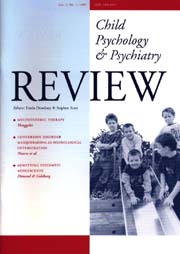No CrossRef data available.
Article contents
Commentary: Assessing the Risks Presented by Parents
Published online by Cambridge University Press: 26 September 2001
Abstract
The model outlined in the paper by Partridge, Casswell and Richardson is an interesting one. Its strengths are particularly the multidisciplinary nature of the assessment and its extension over a period of time, allowing for the assessment to be also a therapeutic process. It stands in contrast to many single-handed expert assessments carried out as a cross sectional view of the family at one particular point.
The decision not to meet with the children is understandable on the basis that the children may well have been seen by other professionals. However, since parenting is a dyadic interaction it can only be observed by meeting with both parents and children together. The notion of risk and assessment of risk is broader than the risk posed by an adult or parent to a generic child. Beyond a capacity to injure and physically or sexually abuse, risk extends to emotional abuse or injury and emotional neglect, insensitivity or inability to meet the child's developmental needs. An assessment of these capacities is best related to the needs of particular children and includes issues of attachment. These can only be assessed by meeting with the children and/or the children and parents together.
The addition to the team of an adult psychiatrist with a particular interest in personality and the influence of early experiences on adult functioning has been found to be of great value.
An alternative model is the multi-family intensive assessment process, during which several families attend together for a short period of time and during which intra-family interactions as well as group processes are observed.
- Type
- Research Article
- Information
- Copyright
- © 2001 Association for Child Psychology and Psychiatry




